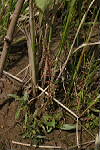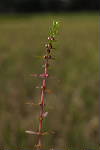

Botany Biology Phenology Ecology Distribution Agricultural importance Cultural control Chemical control
| Description : | Terrestrial, annual, erect herb, up to 60 cm tall. Taproot white or brown. Stem quadrangular, solid, glabrous. Stipules absent. Leaves simple, not lobed or divided, opposite, sessile, lanceolate, less than 2 cm long/wide, margin entire, apex acute or obtuse, base cordate or obtuse, one-veined. Flowers bisexual, grouped together in an axillary, sessile glomerules, red, pink, or purple, petals absent. Fruit a capsule, opening irregularly, transversely. |